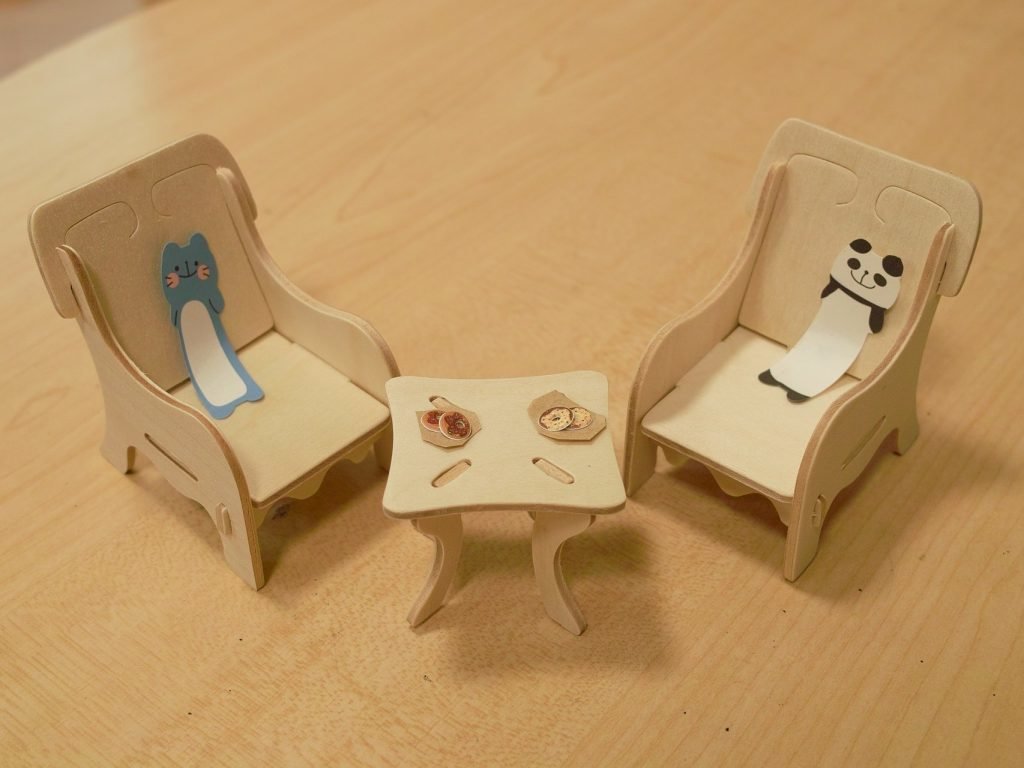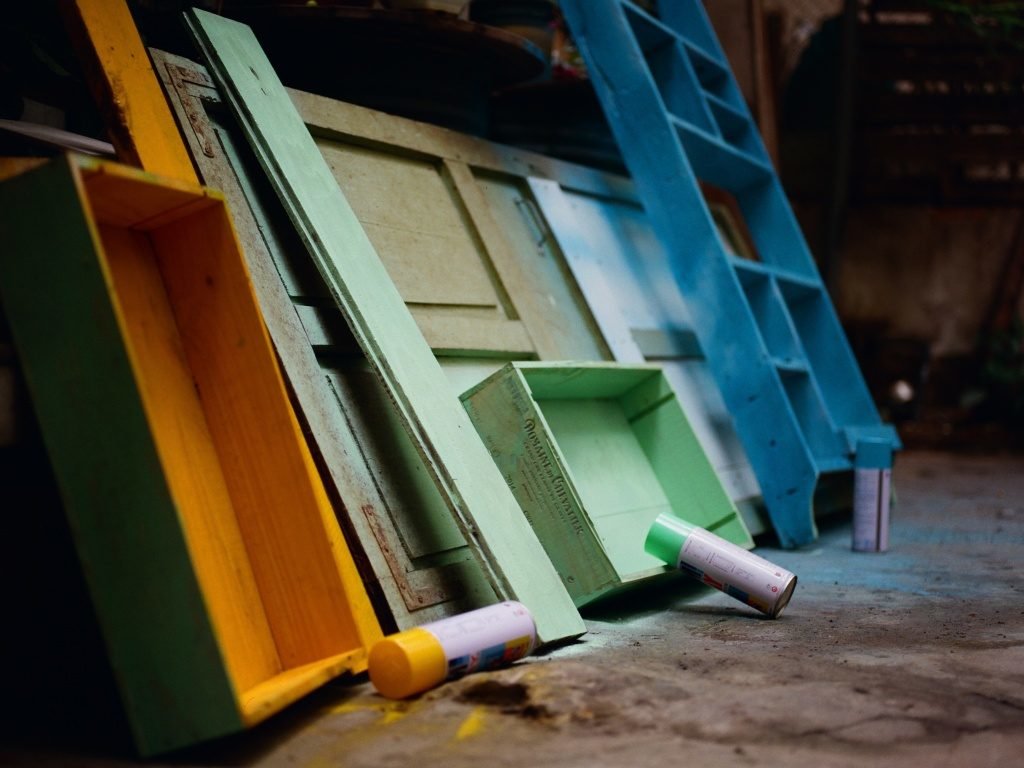Many people are concerned about the health risks involved in the use of Medium Density Fibreboard.
I was one of the first users of MDF in the UK before it became generally available and recognized for its versatility, stability and, finish. And I know what an unpleasant dust it is to work with. Not only is it an irritant to throat and nose, but the dust is incredibly powder-like and invasive.
However once the work has been finished, either with paint it seems that MDF dust ceases to pose a risk.
What is MDF?
Wood based boards are used almost everywhere, there are three main types;
Laminated Board
Differing wood grain is used for each layer and is then glued together giving the wood increased rigidity. Types of laminated wood include plywood and blockboard.
Particle Boards
For example wood chipboard or flex board. Here raw material is processed to produce particles of varying size and is then bonded with a resin binder.
Fibre Boards
Types of fibreboard are differentiated by the size and type of wood fibres used, the method of drying, what type of bonding agent is used and the method by which it is pressed into shape.
Medium Density Fibreboard is manufactured by a dry process at a lower temperature than for example hardboard, another type of fibreboard.
The effect of this is that the natural glues and resins contained within the wood are rendered ineffective. MDF therefore uses manufactured bonding agents and resins.
Varying density boards with differing finishes are used for various end uses.
Why Be Concerned About MDF?
In all fibreboards, formaldehyde resins are used to bond together the constituent parts. This is usually urea formaldehyde, but some fibreboard including exterior or marine quality board will use stronger glues such as phenol formaldehyde.
Even at a low level, exposure to formaldehyde through inhalation can cause irritation to the eyes, nose, throat and mucous membrane.
Formaldehyde can also affect the skin, leading to dermatitis, and the respiratory system causing asthma and rhinitis.
The International Agency for Research on Cancer (IARC), part of the World Health Organisation, quoted evidence that even short term exposure to formaldehyde, at far below the legal limit
allowable in Britain, could cause irritation to the eyes, nose and throat.
The IARC’s findings also stated that wood dust is a carcinogen’ (cancer causing) and that ‘formaldehyde is probably carcinogenic to humans’. IARC was also concerned about the reproductive hazards of formaldehyde’.
Formaldehyde is classified in the UK and throughout Europe as a Category 3 Carcinogen. This means it is a substance which “causes concern for humans owing to possible carcinogenic effects but, in respect of which, available information is not adequate for making a satisfactory assessment.”
This
puts formaldehyde on the GPMU list of potential carcinogens, meaning it should be replaced where possible, and if not, subject to rigorous controls that reduce exposure to the lowest possible level.
Have Other Countries Banned the Use of MDF?
Rumours that MDF is banned in America and/or Australia are unfounded.
However the US limits formaldehyde emissions from MDF to 0.3ppm (parts per million), and homeowners in California were warned that their new home had been built using MDF: which “contains a chemical known to cause cancer, birth defects or other reproductive hazards”.
Australia has a tighter exposure standard than Britain and warns its workers that formaldehyde is ‘a probable carcinogen’ and a sensitiser (i.e. it can cause allergic reaction such as asthma).
In Germany the exposure limit is 0.lppm, and Norway and Hungary both have lower exposure limits than Britain and list formaldehyde as an allergen and probable carcinogen.
In the UK, the Health and Safety Commission’s Advisory Committee on Toxic Substances is now being asked to review the hazards of working with MDF.
What Can be Done to Reduce the Risks from MDF?
Formaldehyde is recognised by the Health and Safety Executive as a hazardous substance and as such has been given a Maximum Exposure Limit (MEL).
The MEL for formaldehyde is 2ppm and at no time should this limit be exceeded. The Control of Substances Hazardous to Health Regulations (COSHH) 1994 states that an employer must try to get as far below a MEL asis reasonably practicable.
The employer has a general duty to ensure the health, safety and welfare of their employees. Under the Management of Health and Safety at Work Regulations 1992 (Regulation 3), an employer is legally obliged to carry out a risk assessment.
This risk assessment should lead the employer to introduce measures to eliminate or adequately reduce risks.
COSHH Regulation 6 further states that, no employer may carry on any work liable to expose employees to substances hazardous to health, unless a suitable and sufficient assessment of the risks created by that work, and of the steps needed to comply with COSHH in respect of it, has been made.
If formaldehyde in MDF is being used, and cut or worked, at your workplace your employer should first try to use a safer material.
If there is no alternative to using fibreboard then your employer should consider low emission board.
Some board manufacturers are advertising low formaldehyde or zero formaldehyde emission boards made to the stringent German ‘E1’ standard. This standard is currently being reviewed by the European Union.
Where dust cannot be eliminated, the employer has to introduce control measures which will adequately reduce dust levels. This will require adequate ventilation.
The most effective control measure is Local Exhaust Ventilation. The exhaust mechanism is normally attached to the workstation where board is being cut. As wood fibres are released from the board the exhaust should remove them from workplace air.
This ensures that most of the dust is removed from the atmosphere as board is worked. Your employer should also keep the workplace clean and ensure that the workplace is free of any dust.
Gloves should be provided to avoid formaldehyde coming into contact with the skin, and suitable masks should be provided to avoid inhalation or ingestion of fibres.
The Health and Safety Executive (HSE) has announced the publication of a Hazard Assessment Document for medium density fibreboard (MDF).
The publication of this document follows on from an announcement in October 1997 that HSE would be reviewing the health effects of exposures arising from machining MDF.
As part of the review HSE carried out a hazard assessment and commissioned an exposure survey and research into the characteristics of MDF dust/exposures.
MDF is a wood composite material, primarily softwood, bonded with a synthetic resin, which is usually formaldehyde-based. It is used industrially in furniture and cabinet making.
The atmosphere typically created by machining MDF contains a mixture of softwood dust (and hardwood dust if hardwood is present in the MDF), free formaldehyde, dust particles onto which formaldehyde is adsorbed and, potentially, the resin binder itself and its derivatives.
The Hazard Assessment Document for MDF reports on the scientific evidence for the possible health effects of exposures arising from machining MDF and includes information from the HSE commissioned research on the atmosphere created during the machining of MDF.
This is the first of a series of Hazard Assessment Documents that will be published by HSE.
The health effects of constituents of MDF are: · Formaldehyde can cause irritation of the eyes, nose and throat. In experimental studies in rats, formaldehyde causes nasal cancer.
However, there is no evidence that it has caused cancer, either nasal or other, in humans.
Some softwood and hardwood dusts can cause asthma. There is some evidence for more frequent reporting of respiratory symptoms such as nasal obstruction in workers receiving exposures arising from machining MDF compared to other forms of wood or wood products. WATCH expressed the view that the most appropriate risk management strategy for MDF is the one currently recommended by HSE.
This specifies that: · The level of dust arising from the machining of MDF should be kept to as low as reasonably practicable below the Maximum Exposure Limits (MELs) for softwood dust and hardwood dust.
Levels of free formaldehyde should be kept as low as reasonably practicable below the MELs for formaldehyde.
Softwood and hardwood dusts each have an 8-hour time weighted average MEL of 5mg m-3 (total inhalable dust), whilst formaldehyde has MELs of 2 ppm, as an 8-hour time weighted average and as a 15-minute short term exposure limit.
HSE is also preparing free guidance for publication next year aimed at those who use MDF at work. It will summarise the conclusions of the Hazard Assessment Document and the recently commissioned research and will provide a guide to working safely with MDF.
Further Information Copies of the new publication, ‘Medium Density Fibreboard – Hazard Assessment Document, EH75/1, ISBN 0 7176 1735 1, are available from:
HSE Books, PO Box 1999, Sudbury, Suffolk CO10 2WA (tel 01787-881165).

